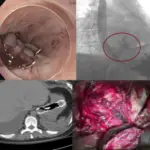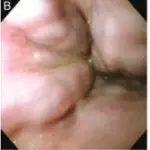Barrett esophagus is a condition in which the flat pink lining of the swallowing tube that connects the mouth to the stomach esophagus becomes damaged by acid reflux, which causes the lining to thicken and become red.
What is the Pathology of Barrett Esophagus?
The pathology of barrett esophagus is:
-Etiology: The cause of barrett esophagus is not yet known. However, the condition is most often seen in people with GERD.
-Genes involved: MSR1, CTHRC1, and ASCC1.
-Pathogenesis: The sequence of events that lead to barrett esophagus are metaplastic columnar mucosa containing epithelial cells with gastric and intestinal features replaces esophageal squamous mucosa damaged by gastroesophageal reflux disease.
-Histology: The histology associated with barrett esophagus shows an acquired condition that results from chronic gastro-esophageal reflux. It is characterized by the metaplastic replacement of the normal squamous epithelium of the lower oesophagus by columnar epithelium.
How does Barrett Esophagus Present?
Patients with barrett esophagus typically in male and present at age range of over 50-years-old. The symptoms, features, and clinical findings associated with barrett esophagus include heartburn, regurgitation of stomach contents, and difficulty swallowing.
How is Barrett Esophagus Diagnosed?
Barrett esophagus is diagnosed by endoscopy.
How is Barrett Esophagus Treated?
Barrett esophagus is treated by proton pump inhibitors, and photodynamic therapy.
What is the Prognosis of Barrett Esophagus?
The prognosis of Barrett esophagus is good.



